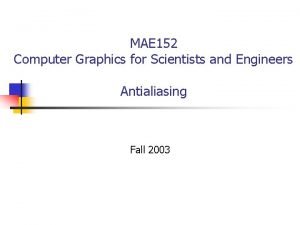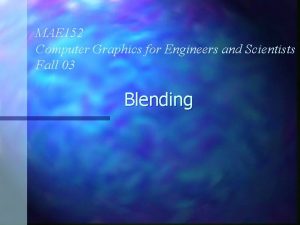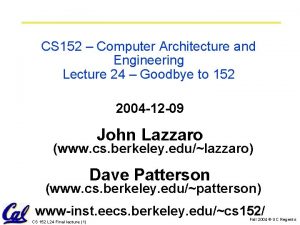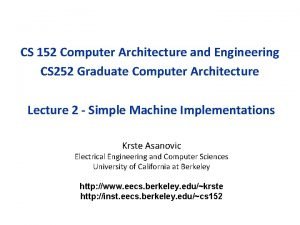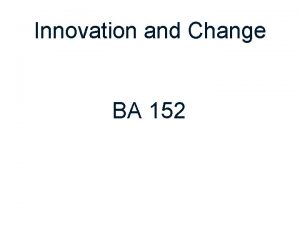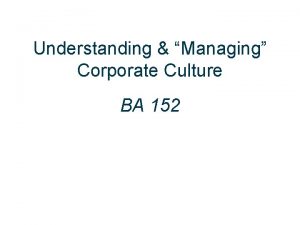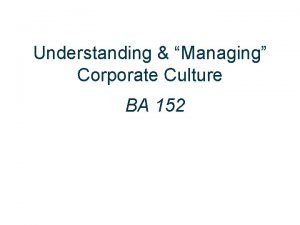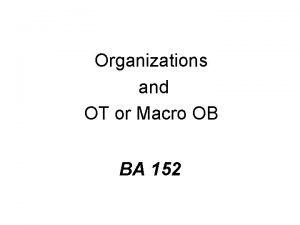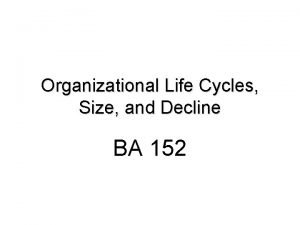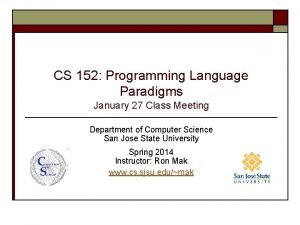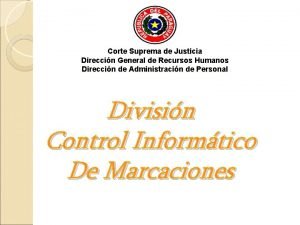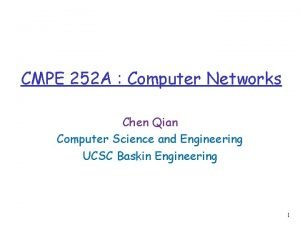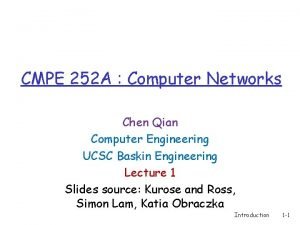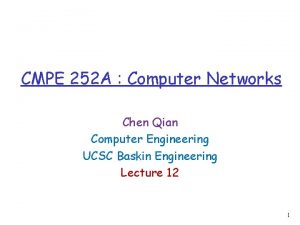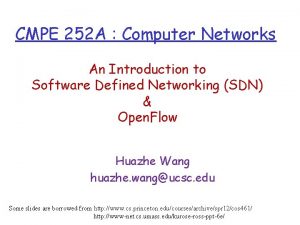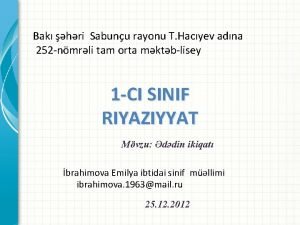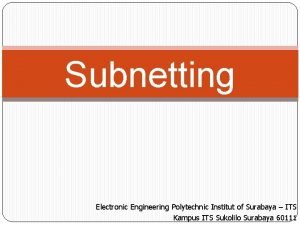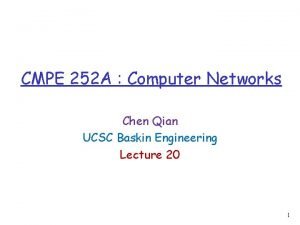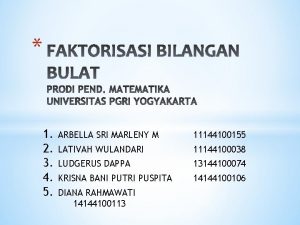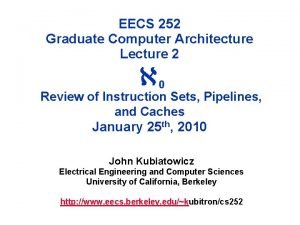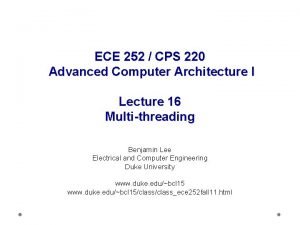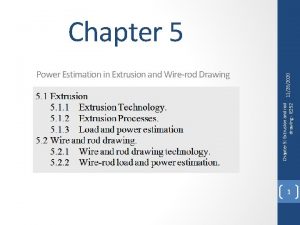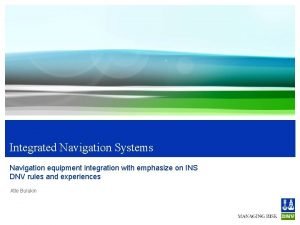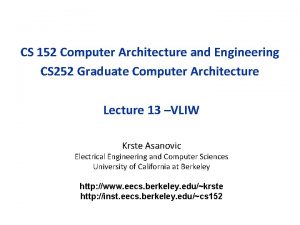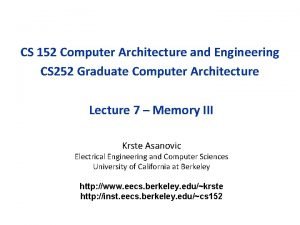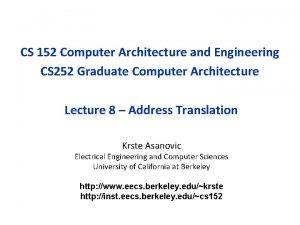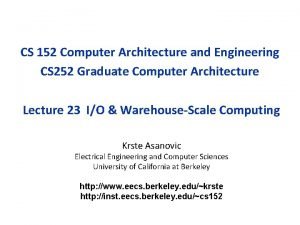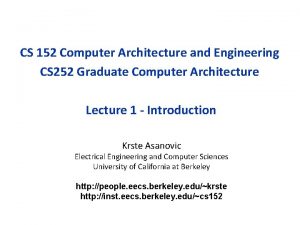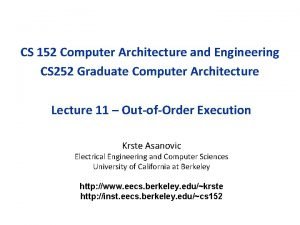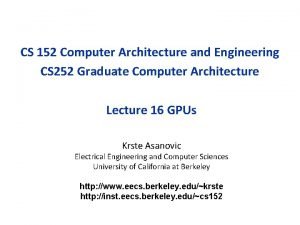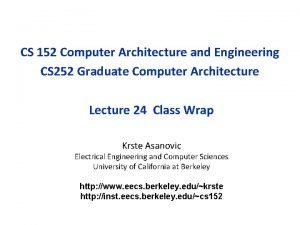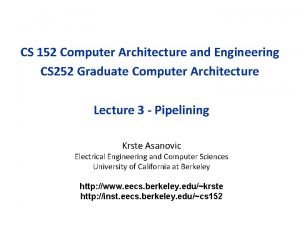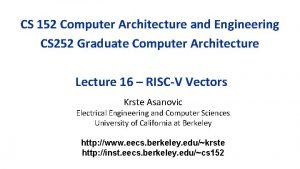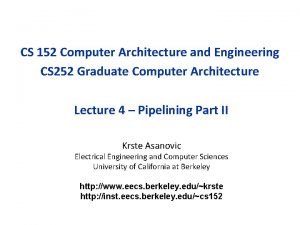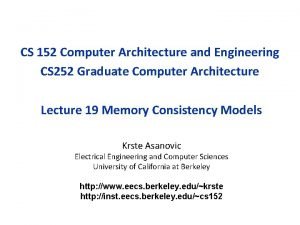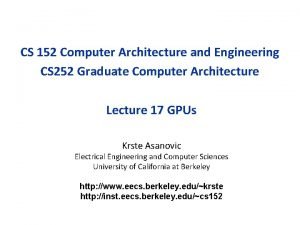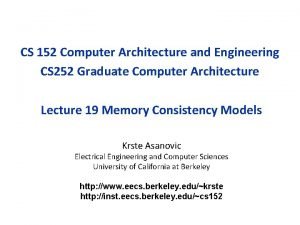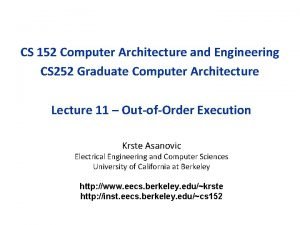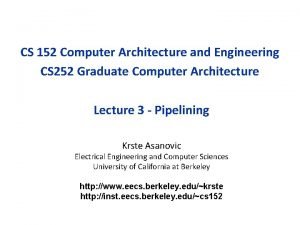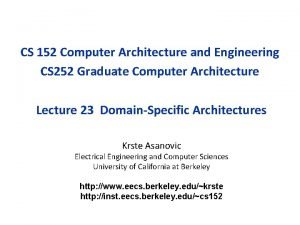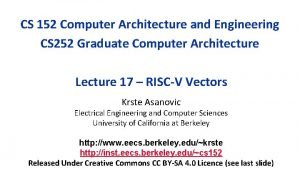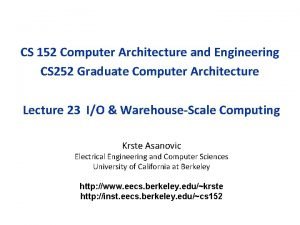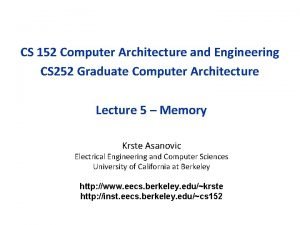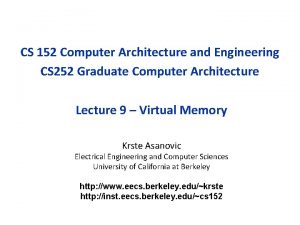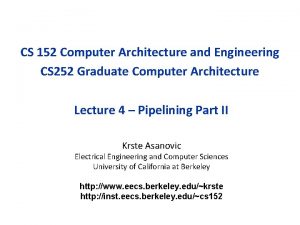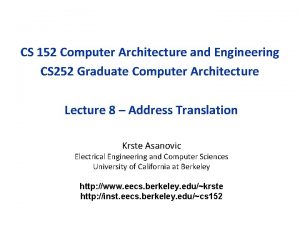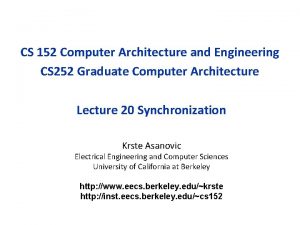CS 152 Computer Architecture and Engineering CS 252















![LW: JAL: Branch: Microcode Sketches (2) A: =Reg[rs 1] B: =Imm. I //Sign-extend 12 LW: JAL: Branch: Microcode Sketches (2) A: =Reg[rs 1] B: =Imm. I //Sign-extend 12](https://slidetodoc.com/presentation_image/49b0dad478ae866424581f3526658324/image-16.jpg)









![Implementing Complex Instructions Memory-memory add: M[rd] = M[rs 1] + M[rs 2] Address µPC Implementing Complex Instructions Memory-memory add: M[rd] = M[rs 1] + M[rs 2] Address µPC](https://slidetodoc.com/presentation_image/49b0dad478ae866424581f3526658324/image-26.jpg)



















- Slides: 45

CS 152 Computer Architecture and Engineering CS 252 Graduate Computer Architecture Lecture 2 - Simple Machine Implementations Krste Asanovic Electrical Engineering and Computer Sciences University of California at Berkeley http: //www. eecs. berkeley. edu/~krste http: //inst. eecs. berkeley. edu/~cs 152

Last Time in Lecture 1 § Computer Architecture >> ISAs and RTL – CS 152 is about interaction of hardware and software, and design of appropriate abstraction layers § Technology and Applications shape Computer Architecture – History provides lessons for the future § First 130 years of Comp. Arch, from Babbage to IBM 360 – Move from calculators (no conditionals) to fully programmable machines – Rapid change started in WWII (mid-1940 s), move from electro-mechanical to pure electronic processors § Cost of software development becomes a large constraint on architecture (need compatibility) § IBM 360 introduces notion of “family of machines” running same ISA but very different implementations – Six different machines released on same day (April 7, 1964) – “Future-proofing” for subsequent generations of machine 2

Instruction Set Architecture (ISA) § The contract between software and hardware § Typically described by giving all the programmer-visible state (registers + memory) plus the semantics of the instructions that operate on that state § IBM 360 was first line of machines to separate ISA from implementation (aka. microarchitecture) § Many implementations possible for a given ISA – E. g. , the Soviets build code-compatible clones of the IBM 360, as did Amdahl after he left IBM. – E. g. 2. , today you can buy AMD or Intel processors that run the x 86 -64 ISA. – E. g. 3: many cellphones use the ARM ISA with implementations from many different companies including Apple, Qualcomm, Samsung, Huawei, etc. § We use Berkeley RISC-V as standard ISA in class – www. riscv. org 3

ISA to Microarchitecture Mapping § ISA often designed with particular microarchitectural style in mind, e. g. , Accumulator hardwired, unpipelined CISC microcoded RISC hardwired, pipelined VLIW fixed-latency in-order parallel pipelines JVM software interpretation § But can be implemented with any microarchitectural style – Intel Ivy Bridge: hardwired pipelined CISC (x 86) machine (with some microcode support) – Spike: Software-interpreted RISC-V machine – ARM Jazelle: A hardware JVM processor – This lecture: a microcoded RISC-V machine 4

Why Learn Microprogramming? § To show to build very small processors with complex ISAs § To help you understand where CISC* machines came from § Because still used in common machines (x 86, IBM 360, Power. PC) § As a gentle introduction into machine structures § To help understand how technology drove the move to RISC* * “CISC”/”RISC” names much newer than style of machines they refer to. 5

Control versus Datapath § Processor designs can be split between datapath, where numbers are stored and arithmetic operations computed, and control, which sequences operations on datapath § Biggest challenge for early Control Registers ALU Busy? Address Data Inst. Reg. PC Datapath Instruction Control Lines Condition? Main Memory computer designers was getting control circuitry correct § Maurice Wilkes invented the idea of microprogramming to design the control unit of a processor for EDSAC-II, 1958 - Foreshadowed by Babbage’s “Barrel” and mechanisms in earlier programmable calculators 6

Microcoded CPU Next State Condition Opcode Busy? µPC Microcode ROM (holds fixed µcode instructions) Decoder Control Lines Datapath Address Data Main Memory (holds user program written in macroinstructions, e. g. , x 86, RISC-V) 7

Technology Influence § When microcode appeared in 50 s, different technologies for: – Logic: Vacuum Tubes – Main Memory: Magnetic cores – Read-Only Memory: Diode matrix, punched metal cards, … § Logic very expensive compared to ROM or RAM § ROM cheaper than RAM § ROM much faster than RAM 8

RISC-V ISA § New fifth-generation RISC design from UC Berkeley § Realistic & complete ISA, but open & small § Not over-architected for a certain implementation style § Both 32 -bit (RV 32) and 64 -bit (RV 64) address-space variants § Designed for multiprocessing § Efficient instruction encoding § Easy to subset/extend for education/research § Techreport with RISC-V spec available on class website § Increasing momentum with industry adoption § Please see CS 61 C Fall 2017, Lectures 5 -7 for RISC-V ISA review: http: //inst. eecs. berkeley. edu/~cs 61 c/fa 17/ 9

RV 32 Processor State Program counter (pc) 32 x 32 -bit integer registers (x 0 -x 31) • x 0 always contains a 0 32 floating-point (FP) registers (f 0 -f 31) • each can contain a single- or doubleprecision FP value (32 -bit or 64 -bit IEEE FP) FP status register (fsr), used for FP rounding mode & exception reporting 10

RISC-V Instruction Encoding § Can support variable-length instructions. § Base instruction set (RV 32) always has fixed 32 -bit instructions lowest two bits = 112 § All branches and jumps have targets at 16 -bit granularity (even in base ISA where all instructions are fixed 32 bits) 11

RISC-V Instruction Formats Additional Reg. Source 2 opcode bits/immediat Reg. Source 1 e 7 -bit opcode Destination field (but low 2 bits =112) Reg. 12

Reg. En ALU Mem. W MALd Reg. W BLd ALUOp B A ALUEn Mem. Address Data Out In Busy? Condition? ALd Address Registers Imm. Sel Immediate Imm. En Reg. Sel Register RAM PC Inst. Ld Instruction Reg. Opcode rs 1 rs 2 rd 32 (PC) Single-Bus Datapath for Microcoded RISC-V Main Memory Mem. En Microinstructions written as register transfers: § MA: =PC means Reg. Sel=PC; Reg. W=0; Reg. En=1; MALd=1 § B: =Reg[rs 2] means Reg. Sel=rs 2; Reg. W=0; Reg. En=1; BLd=1 § Reg[rd]: =A+B means ALUop=Add; ALUEn=1; Reg. Sel=rd; Reg. W=1 13

RISC-V Instruction Execution Phases § Instruction Fetch § Instruction Decode § Register Fetch § ALU Operations § Optional Memory Operations § Optional Register Writeback § Calculate Next Instruction Address 14

Microcode Sketches (1) Instruction Fetch: MA, A: =PC PC: =A+4 wait for memory IR: =Mem dispatch on opcode ALU: A: =Reg[rs 1] B: =Reg[rs 2] Reg[rd]: =ALUOp(A, B) goto instruction fetch ALUI: A: =Reg[rs 1] B: =Imm. I //Sign-extend 12 b immediate Reg[rd]: =ALUOp(A, B) goto instruction fetch 15
![LW JAL Branch Microcode Sketches 2 A Regrs 1 B Imm I Signextend 12 LW: JAL: Branch: Microcode Sketches (2) A: =Reg[rs 1] B: =Imm. I //Sign-extend 12](https://slidetodoc.com/presentation_image/49b0dad478ae866424581f3526658324/image-16.jpg)
LW: JAL: Branch: Microcode Sketches (2) A: =Reg[rs 1] B: =Imm. I //Sign-extend 12 b immediate MA: =A+B wait for memory Reg[rd]: =Mem goto instruction fetch Reg[rd]: =A // Store return address A: =A-4 // Recover original PC B: =Imm. J // Jump-style immediate PC: =A+B goto instruction fetch A: =Reg[rs 1] B: =Reg[rs 2] if (!ALUOp(A, B)) goto instruction fetch //Not taken A: =PC //Microcode fall through if branch taken A: =A-4 B: =Imm. B// Branch-style immediate PC: =A+B goto instruction fetch 16

Pure ROM Implementation Opcode Cond? Busy? µPC Address ROM Data Next µPC Control Signals § How many address bits? |µaddress| = |µPC|+|opcode|+ 1 § How many data bits? |data| = |µPC|+|control signals| = |µPC| + 18 § Total ROM size = 2|µaddress|x|data| 17

Pure ROM Contents µPC fetch 0 fetch 1 fetch 2 …. ALU 0 ALU 1 ALU 2 Address Opcode Cond? Busy? X X X 1 X X 0 ALU X X ALUI X X LW X X | Data | Control Lines | MA, A: =PC | | IR: =Mem | PC: =A+4 Next µPC fetch 1 fetch 2 ALU 0 ALUI 0 LW 0 X X X | A: =Reg[rs 1] | B: =Reg[rs 2] | Reg[rd]: =ALUOp(A, B) ALU 1 ALU 2 fetch 0 X X X 18

Single-Bus Microcode RISC-V ROM Size § Instruction fetch sequence 3 common steps § ~12 instruction groups § Each group takes ~5 steps (1 for dispatch) § Total steps 3+12*5 = 63, needs 6 bits for µPC § Opcode is 5 bits, ~18 control signals § Total size = 2(6+5+2)x(6+18)=213 x 24 = ~25 Ki. B! 19

Reducing Control Store Size § Reduce ROM height (#address bits) – Use external logic to combine input signals – Reduce #states by grouping opcodes § Reduce ROM width (#data bits) – Restrict µPC encoding (next, dispatch, wait on memory, …) – Encode control signals (vertical µcoding, nanocoding) 20

Single-Bus RISC-V Microcode Engine Opcode fetch 0 Decode µPC Cond? Busy? µPC Jump Logic +1 Address ROM Data µPC jump Control Signals µPC jump = next | spin | fetch | dispatch | ftrue | ffalse 21

µPC Jump Types § next increments µPC § spin waits for memory § fetch jumps to start of instruction fetch § dispatch jumps to start of decoded opcode group § fture/ffalse jumps to fetch if Cond? true/false 22

Encoded ROM Contents Address µPC fetch 0 fetch 1 fetch 2 | Data | Control Lines | MA, A: =PC | IR: =Mem | PC: =A+4 Next µPC next spin dispatch ALU 0 ALU 1 ALU 2 | A: =Reg[rs 1] | B: =Reg[rs 2] | Reg[rd]: =ALUOp(A, B) next fetch Branch 0 Branch 1 Branch 2 Branch 3 Branch 4 Branch 5 | A: =Reg[rs 1] | B: =Reg[rs 2] | A: =PC | A: =A-4 | B: =Imm. B | PC: =A+B next ffalse next fetch 23

CS 152 Administrivia § Grading clarifications – You must complete 3/5 labs or get an automatic F regardless of other grades § Slip days – Problem sets have no slip days – Labs have two free extensions (max one per lab) until next class after due date – No other extensions without documented emergency 24

CS 252 Administrivia § CS 252 Readings on Website – Must use Piazza to send private note on each per paper thread to instructors before midnight Sunday before Monday discussion containing paper report: • Write one paragraph on main content of paper including good/bad points of paper • Also, 1 -3 questions about paper for discussion • First two “ 360 Architecture”, “B 5000 Architecture” § CS 252 Project Timeline – Proposal due Sunday midnight March 4 th – One page including: • project title • team members (2 per project) • what problem are you trying to solve? • what is your approach? • infrastructure to be used • timeline/milestones 25
![Implementing Complex Instructions Memorymemory add Mrd Mrs 1 Mrs 2 Address µPC Implementing Complex Instructions Memory-memory add: M[rd] = M[rs 1] + M[rs 2] Address µPC](https://slidetodoc.com/presentation_image/49b0dad478ae866424581f3526658324/image-26.jpg)
Implementing Complex Instructions Memory-memory add: M[rd] = M[rs 1] + M[rs 2] Address µPC MMA 0 MMA 1 MMA 2 MMA 3 MMA 4 MMA 5 MMA 6 | Data | Control Lines | MA: =Reg[rs 1] | A: =Mem | MA: =Reg[rs 2] | B: =Mem | MA: =Reg[rd] | Mem: =ALUOp(A, B) | Next µPC next spin fetch Complex instructions usually do not require datapath modifications, only extra space for control program Very difficult to implement these instructions using a hardwired controller without substantial datapath modifications 26

Reg. En ALU Mem. W MALd Reg. W BLd ALUOp B A ALUEn Mem. Address Data Out In Busy? Condition? ALd Address Registers Imm. Sel Immediate Imm. En Reg. Sel Register RAM PC Inst. Ld Instruction Reg. Opcode rs 1 rs 2 rd 32 (PC) Single-Bus Datapath for Microcoded RISC-V Main Memory Mem. En Datapath unchanged for complex instructions! 27

Horizontal vs Vertical µCode Bits per µInstruction # µInstructions § Horizontal µcode has wider µinstructions – Multiple parallel operations per µinstruction – Fewer microcode steps per macroinstruction – Sparser encoding more bits § Vertical µcode has narrower µinstructions – Typically a single datapath operation per µinstruction § separate µinstruction for branches – More microcode steps per macroinstruction – More compact less bits § Nanocoding – Tries to combine best of horizontal and vertical µcode 28

Nanocoding Exploits recurring control signal patterns in µcode, e. g. , ALU 0 A �Reg[rs 1]. . . ALUI 0 A �Reg[rs 1]. . . �PC (state) µcode next-state µaddress µcode ROM nanoaddress nanoinstruction ROM data § Motorola 68000 had 17 -bit µcode containing either 10 -bit µjump or 9 -bit nanoinstruction pointer – Nanoinstructions were 68 bits wide, decoded to give 196 control signals 29

Microprogramming in IBM 360 M 30 Datapath width (bits) µinst width (bits) µcode size (K µinsts) µstore technology µstore cycle (ns) memory cycle (ns) Rental fee ($K/month) M 40 M 50 M 65 8 16 32 64 50 52 85 87 4 4 2. 75 CCROS TCROS BCROS 750 625 500 200 1500 2000 750 4 7 15 35 § Only the fastest models (75 and 95) were hardwired 30

IBM Card-Capacitor Read-Only Storage Punched Card with metal film Fixed sensing plates [ IBM Journal, January 1961] 31

Microcode Emulation § IBM initially miscalculated the importance of software compatibility with earlier models when introducing the 360 series § Honeywell stole some IBM 1401 customers by offering translation software (“Liberator”) for Honeywell H 200 series machine § IBM retaliated with optional additional microcode for 360 series that could emulate IBM 1401 ISA, later extended for IBM 7000 series – one popular program on 1401 was a 650 simulator, so some customers ran many 650 programs on emulated 1401 s – (650 simulated on 1401 emulated on 360) 32

Microprogramming thrived in ‘ 60 s and ‘ 70 s § Significantly faster ROMs than DRAMs were available § For complex instruction sets, datapath and controller were cheaper and simpler § New instructions , e. g. , floating point, could be supported without datapath modifications § Fixing bugs in the controller was easier § ISA compatibility across various models could be achieved easily and cheaply Except for the cheapest and fastest machines, all computers were microprogrammed 33

Microprogramming: early Eighties § Evolution bred more complex micro-machines – Complex instruction sets led to need for subroutine and call stacks in µcode – Need for fixing bugs in control programs was in conflict with read-only nature of µROM – Writable Control Store (WCS) (B 1700, QMachine, Intel i 432, …) § With the advent of VLSI technology assumptions about ROM & RAM speed became invalid more complexity § Better compilers made complex instructions less important. § Use of numerous micro-architectural innovations, e. g. , pipelining, caches and buffers, made multiple-cycle execution of reg-reg instructions unattractive 34

VAX 11 -780 Microcode 35

Writable Control Store (WCS) § Implement control store in RAM not ROM – MOS SRAM memories now almost as fast as control store (core memories/DRAMs were 2 -10 x slower) – Bug-free microprograms difficult to write § User-WCS provided as option on several minicomputers – Allowed users to change microcode for each processor § User-WCS failed – – – Little or no programming tools support Difficult to fit software into small space Microcode control tailored to original ISA, less useful for others Large WCS part of processor state - expensive context switches Protection difficult if user can change microcode Virtual memory required restartable microcode 36

Analyzing Microcoded Machines § John Cocke and group at IBM – Working on a simple pipelined processor, 801, and advanced compilers inside IBM – Ported experimental PL. 8 compiler to IBM 370, and only used simple register-register and load/store instructions similar to 801 – Code ran faster than other existing compilers that used all 370 instructions! (up to 6 MIPS whereas 2 MIPS considered good before) § Emer, Clark, at DEC – Measured VAX-11/780 using external hardware – Found it was actually a 0. 5 MIPS machine, although usually assumed to be a 1 MIPS machine – Found 20% of VAX instructions responsible for 60% of microcode, but only account for 0. 2% of execution time! § VAX 8800 – Control Store: 16 K*147 b RAM, Unified Cache: 64 K*8 b RAM – 4. 5 x more microstore RAM than cache RAM! 37

“Iron Law” of Processor Performance Time = Instructions Cycles Time Program * Instruction * Cycle § Instructions per program depends on source code, compiler technology, and ISA § Cycles per instructions (CPI) depends on ISA and µarchitecture § Time per cycle depends upon the µarchitecture and base technology 38

CPI for Microcoded Machine 7 cycles Inst 1 5 cycles Inst 2 10 cycles Inst 3 Time Total clock cycles = 7+5+10 = 22 Total instructions = 3 CPI = 22/3 = 7. 33 CPI is always an average over a large number of instructions. 39

IC Technology Changes Tradeoffs § Logic, RAM, ROM all implemented using MOS transistors § Semiconductor RAM ~ same speed as ROM 40

Reconsidering Microcode Machine (Nanocoded 68000 example) ! C S RI C P er Us Exploits recurring control signal patterns in µcode, e. g. , ALU 0 A �Reg[rs 1]. . . ALUI 0 A �Reg[rs 1]. . . �PC (state) e h ac µcode next-state µaddress C. st In nanoaddress µcode ROM e d o c e D d e r i data w nanoinstruction ROM d r a H § Motorola 68000 had 17 -bit µcode containing either 10 -bit µjump or 9 -bit nanoinstruction pointer – Nanoinstructions were 68 bits wide, decoded to give 196 control signals 41

From CISC to RISC § Use fast RAM to build fast instruction cache of user-visible instructions, not fixed hardware microroutines – Contents of fast instruction memory change to fit what application needs right now § Use simple ISA to enable hardwired pipelined implementation – Most compiled code only used a few of the available CISC instructions – Simpler encoding allowed pipelined implementations § Further benefit with integration – In early ‘ 80 s, could finally fit 32 -bit datapath + small caches on a single chip – No chip crossings in common case allows faster operation 42

Berkeley RISC Chips RISC-I (1982) Contains 44, 420 transistors, fabbed in 5 µm NMOS, with a die area of 77 mm 2, ran at 1 MHz. This chip is probably the first VLSI RISC-II (1983) contains 40, 760 transistors, was fabbed in 3 µm NMOS, ran at 3 MHz, and the size is 60 mm 2. Stanford built some too… 43

Microprogramming is far from extinct § Played a crucial role in micros of the Eighties • DEC u. VAX, Motorola 68 K series, Intel 286/386 § Plays an assisting role in most modern micros – e. g. , AMD Bulldozer, Intel Ivy Bridge, Intel Atom, IBM Power. PC, … – Most instructions executed directly, i. e. , with hard-wired control – Infrequently-used and/or complicated instructions invoke microcode § Patchable microcode common for post-fabrication bug fixes, e. g. Intel processors load µcode patches at bootup – Intel had to scramble to resurrect microcode tools and find original microcode engineers to patch Meltdown/Spectre security vulnerabilites 44

Acknowledgements § These slides contain material developed and copyright by: – – – Arvind (MIT) Krste Asanovic (MIT/UCB) Joel Emer (Intel/MIT) James Hoe (CMU) John Kubiatowicz (UCB) David Patterson (UCB) § MIT material derived from course 6. 823 § UCB material derived from course CS 252 45
 Computer architecture and computer organization difference
Computer architecture and computer organization difference Three bus architecture
Three bus architecture What is system design in software engineering
What is system design in software engineering Flowchart for memory reference instructions
Flowchart for memory reference instructions Un r 152
Un r 152 Ntuser.dat forensics
Ntuser.dat forensics Przedszkole 152 łódź
Przedszkole 152 łódź![Law society of tasmania v richardson [2003] tassc 9 Law society of tasmania v richardson [2003] tassc 9](data:image/svg+xml,%3Csvg%20xmlns=%22http://www.w3.org/2000/svg%22%20viewBox=%220%200%20200%20200%22%3E%3C/svg%3E) Law society of tasmania v richardson [2003] tassc 9
Law society of tasmania v richardson [2003] tassc 9 Hundred thousand place
Hundred thousand place Mae 152
Mae 152 Graphics for engineers
Graphics for engineers Cs 152 stanford
Cs 152 stanford Cs 152 berkeley
Cs 152 berkeley Ba 152
Ba 152 Ece 152
Ece 152 Ba 152
Ba 152 Lorne priemaza
Lorne priemaza Which layer of the osi model includes vlans
Which layer of the osi model includes vlans Ba 152
Ba 152 Macroob
Macroob Organizational atrophy
Organizational atrophy Plasa
Plasa Econ 152
Econ 152 Cs152 sjsu
Cs152 sjsu Gfi 152
Gfi 152 Acordada 961/15
Acordada 961/15 Chen qian ucsc
Chen qian ucsc Qian chen ucsc
Qian chen ucsc Cf-252 decay scheme
Cf-252 decay scheme Simplify radical 54
Simplify radical 54 Hops history questions
Hops history questions Cmpe 252
Cmpe 252 Cmpe 252
Cmpe 252 Hexadecimal practice
Hexadecimal practice 252 nömrəli məktəbin müəllimləri
252 nömrəli məktəbin müəllimləri 252 netmask
252 netmask 252 netmask
252 netmask 252 basics
252 basics Cmpe 252
Cmpe 252 Tentukan faktorisasi prima dari 252
Tentukan faktorisasi prima dari 252 252
252 Ece 252
Ece 252 Rod drawing
Rod drawing La factorización prima de 504 es:
La factorización prima de 504 es: Msc.252(83)
Msc.252(83) Dfars 252
Dfars 252




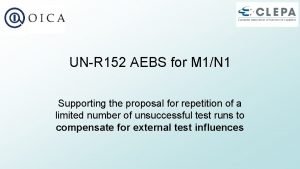
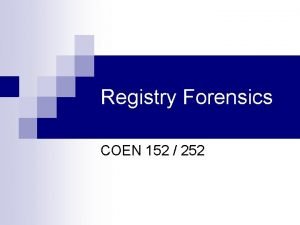

![Law society of tasmania v richardson [2003] tassc 9 Law society of tasmania v richardson [2003] tassc 9](https://slidetodoc.com/wp-content/uploads/2020/10/1024173_0ab07c7fa5fe15bbad1bb1a43f32eeb0-300x225.jpg)

